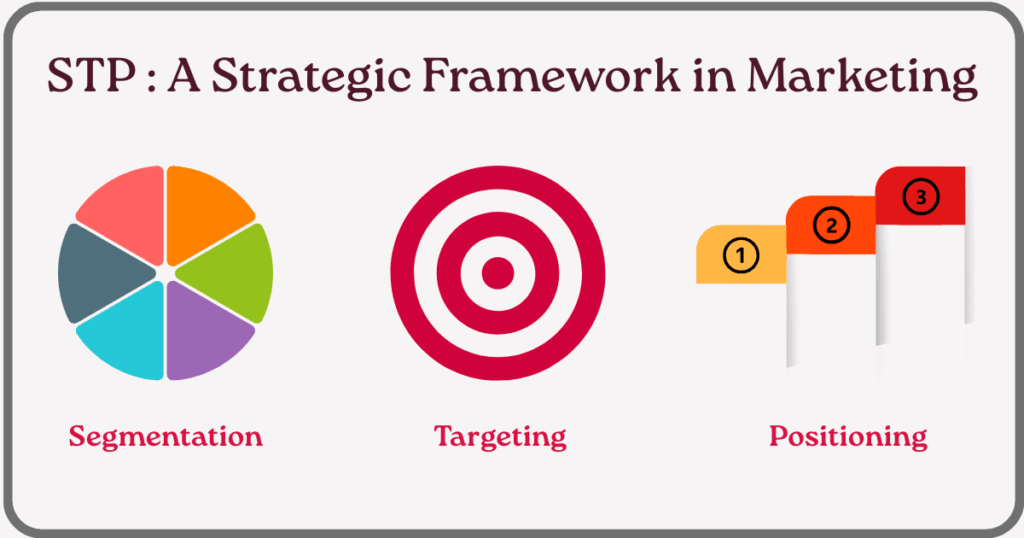
As consumers’ expectations continue to multiply, companies adopting a one-size-fits-all marketing tactic will not be a viable marketing solution for current markets. Instead of focusing on different methods, brands should focus on and invest in understanding their targeted audiences. Choosing the right segments to concentrate on and personalising according to customer needs will open the market to companies. This strategic process involves Segmentation, Targeting, and Positioning, commonly known as an STP framework.
Integrating the STP principles into marketing training helps business professionals develop a strategic mindset, gain deeper consumer insights, and deliver impactful communications. This blog explores how STP operates and its significance in developing practical marketing skills.
Understanding STP: The Strategic Core of Marketing
STP model operates in three stages: identifying audience segments (Segmentation), selecting the most appropriate segment(s) (Targeting), and defining a brand’s message and position within the minds of those audiences (Positioning).

1. Segmentation: Knowing Your Audience
Identifying customer needs and dividing the audience into smaller, manageable groups based on the following characteristics.
- Demographic: Age, Gender, Income, Occupation, Race, Religion, Education, Ethnicity
- Geographic: Region, Climate, Distance from specific locations, Population density
- Psychographic: Lifestyle, Values, Goals, Personality, Interests, Pain points
- Behavioural: Purchasing habits, Brand interactions, Product Usage, Customer loyalty.

Marketing training helps professionals learn more about customer segmentation tailored to their brand and industry, as well as how to collect and analyse data in this process. Organisations can collect data from social media insights, customer surveys and feedback, website analytics, and CRM data.
2. Targeting: Selecting the Right Segment
Targeting is the second step in the STP marketing process. The main goal in Targeting is to review the segments created in the earlier phase and determine which segment can yield better conversions. Targeting may vary depending on the product and campaign type. The segment that is progressing swiftly, is highly gainful, and offers a low-cost acquisition is the one to target.

- Size: Consider the current size of the segment and its potential for future growth.
- Profitability: Analyse and rank the segments based on customers’ lifespans, starting with the most profitable. Focus on the segments with a greater tendency to spend more on the business’s products or services.
- Reachability: From a strategic marketing viewpoint, analyse how easy it is to reach each segment. Focus on customer acquisition costs (CAC’s) and allocate funds toward segments with the lowest CAC. Increased CAC indicates decreased profits.
3. Positioning: Crafting the Right Message
Positioning enables you to highlight your product or service and make it different from competitors, thereby winning the attention of your audience. Since there are many businesses with similar offerings, it’s imperative to identify what differentiates your product.

Gaining a competitive edge can be done through three types of positioning factors:
- Unique Selling Proposition (USP): What sets the brand apart?
- Emotional and functional benefits: How does the brand connect with customer needs?
- Positioning statement: A concise summary of how the brand wants to be perceived
As part of marketing training, professionals should be encouraged to create positioning maps, develop brand storytelling skills, and test positioning messages through focus groups or digital A/B testing.
Conclusion:
Incorporating the STP framework of Segmentation, Targeting and Positioning into marketing training builds strategic thinking capacity. It enables the identification of specific audience segments and the crafting of appropriate brand messages. With the use of this technique, marketers can personalize their campaigns more effectively. Having STP as a focus helps brands keep up with increasing customer expectations and, consequently, stay competitive within the industry. Through systematic marketing training, teams can gain insight and transform it into actionable plans that yield concrete results.

Leave a Reply